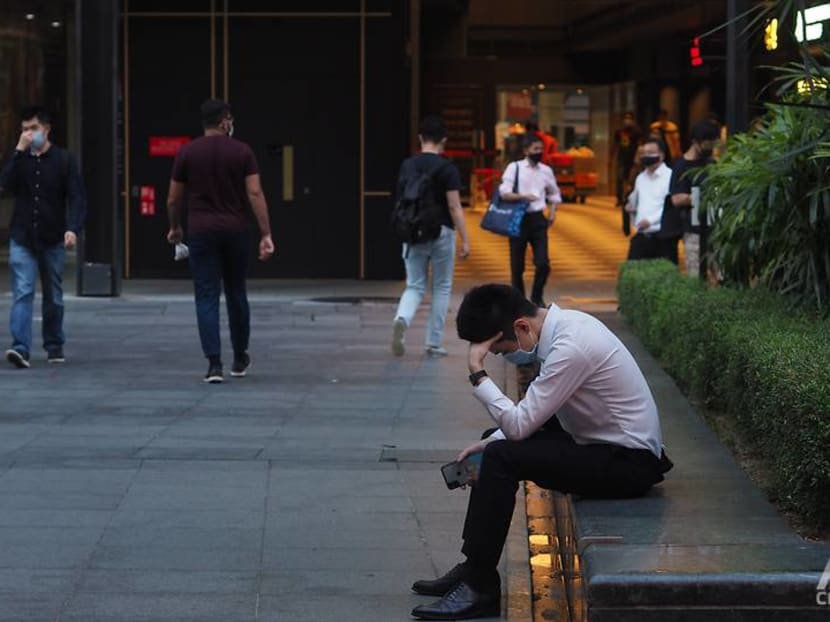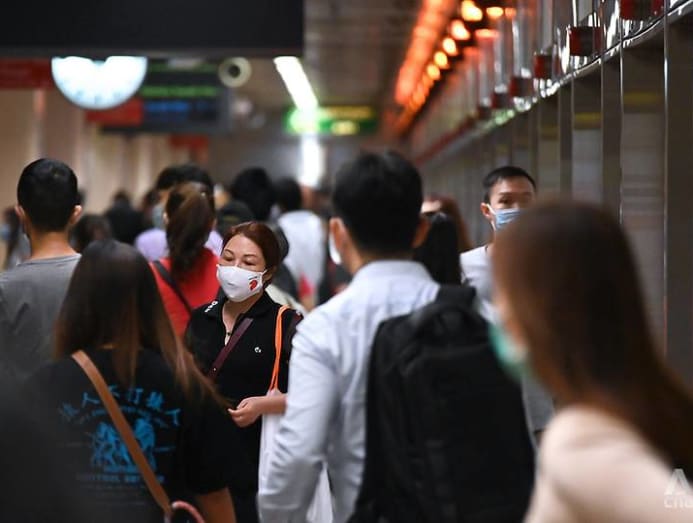Commentary: Workers appreciate mental health days off after a crazy pandemic year
Does your organisation have the necessary support in place if you are feeling burnt out or need time out from work? Mayank Parekh explains what needs to change in the new normal.

The COVID-19 pandemic revealed a need for more mental health support. (File photo: Grace Yeoh)
SINGAPORE: You may have read about Naomi Osaka bowing out of the French Open saying she had to prioritise her mental health over her commercial obligations and professional advancement.
This was a point reiterated by President Halimah who in a Facebook post said people have to walk away from toxic environments despite the stigma.
Because most adults spend the bulk of their time working, the workplace is naturally one environment facing fresh challenges in a new normal. In a 2020 survey by EngageRocket, one in six workers said they felt stressed.
In particular, 30 per cent of employees working in the education sector and 22 per cent from consumer industries indicated their stress levels were unacceptable.
READ: Commentary: Why do some bosses still want their workers to come back to the office?
The 2021 survey results are expected at the end of June and it will come as no surprise if more employees feel this way.
So what can employers do when they find themselves with requests from employees for time out? How can employers tell apart workers feeling isolated and exhausted trying to cope with work and family from those genuinely struggling with issues such as anxiety and depression?
They are two distinct conditions although both could manifest with similar symptoms such as the lack of energy or cynicism towards work and colleagues.
Being aware of these differences can help employers differentiate when adjustments at work may help and when medical interventions including treatment in the form of therapy or medication may be needed instead.

There are useful resources to tap on so that managers can understand the difference. In Singapore, these range from self-help assessment tools such as iWorkHealth developed by the Ministry of Manpower’s Workplace Safety and Health (WSH) Institute to online mental health platforms such as the My Mental Health microsite.
READ: Commentary: I wanted to be a better dad but paternity leave wouldn’t have made a difference
READ: Commentary: Cure to burnout requires a pervasive culture of rest
The Health Promotion Board (HPB) also runs workshops to equip managers and human resource personnel with the knowledge to recognise staff facing difficulties at work and may need help and be supportive leaders at their workplace.
But the reality for many organisations is employees shy away from speaking to their bosses about their personal struggles for fear of being seen as weak or even worse, stigmatised.
So the problem is often not knowing there is a problem in the first place. The good news is that companies can adopt good management practices to uncover insights using data, recognise the sensitivities, set the right tone and nurture a culture of trust and openness on mental wellbeing.
CHECK-INS AND SURVEYS
Almost every company utilises surveys to take the pulse on a number of issues – from corporate culture to change management and views on leadership. Done well, this sort of data provides critical real-time information on how employees feel about their work, their bosses or their prospects in the organisation.
The Harvard Business Review has good resources on how a well-designed survey can lead to quantifiable gains. Tech giant Facebook took things even further and worked with Wharton Professor Adam Grant to study what keeps employees engaged.
Companies that use regular check-ins and surveys to take the pulse of how employees are coping have data to pinpoint where the pain points are instead of relying on “gut feel”.
READ: Commentary: Worries over COVID-19 situation are taking a mental toll on Singapore
READ: Commentary: Call me a strawberry millennial, but being passionate doesn’t mean I’m willing to be exploited
This is especially at a time when WFH is the default and bosses may not get to meet their staff as often as they would like to and cannot have conversations by the corridor that give them a sense of how they are coping.
When done properly, data and insights on employees can drive effective decision-making for the organisation.
For example, HR can have an overview of its entire workforce’s mental well-being and identify opportunities to drive better engagement. Or they can use this data to target interventions on specific departments needing more support.
CHANGES TO HR POLICY
Your company’s HR policies can help promote a conducive environment that respects an individual’s privacy and accommodates those with mental health issues.
While it is not always possible to remove the stigma, keeping mental health information strictly private and confidential and separate from an employee’s normal personnel file can help reassure and encourage more staff struggling to come forward for help.
Some companies have expanded leave policies to allow for mental health days without a medical certificate to encourage people to take time off when they need it and reduce stress and burnout.

LinkedIn gave its 15,900 full-time employees a paid week off in April to help them combat burnout and encourage them to unplug and recharge. Global companies including SAP, Cisco, Google and Thomson Reuters have instituted companywide “mental health days”.
READ: Commentary: Our unkindness on social media is a mirror to society
READ: Commentary: The weird and disorienting uncertainty of starting a new job under COVID-19
Smaller companies with more limited resources can start by instituting more flexi-work arrangements. In 2020, more than 8,000 companies comprising 90,000 employees took advantage of government funding support to implement and sustain flexible work arrangements (FWAs) for all employees.
Flexible employee benefits can be expanded to include mental health consultations and treatments, as well as mental well-being programmes.
Indeed, because working from home has blurred the boundaries, clarity on an after-hours policy is one of the recommendations of the Tripartite Advisory issued in November last year.
Don’t leave it for another day - start relooking longstanding HR policies out of sync with the new realities of work. With more staff aware they can work effectively from anywhere, more employees will feel empowered to ask for flexible work arrangements.
This is especially if they have dependents and find it easier to balance work and family. This will also benefit those who are starting to feel the effects of isolation from going for long periods without interaction with their teams.
Companies that make accommodations to make flexible work as part of their life to get ahead of this curve will get the talent they need who will make an impact to their business.
(Mental health groups have seen a surge in calls since COVID-19 hit. Who are the people tirelessly manning these helplines? Find out on CNA's Heart of the Matter.)
CREATING SUPPORT TEAMS IN COMPANIES
Greater flexible work arrangements, the blurring of boundaries between work and home and managing burnout is bringing into sharper focus this greater burden on the manager to pick up.
So companies must level up managers, support them with these tools and get a handle on what’s going on. When a manager shows that supporting someone with mental health challenges does not mean he is any less valuable or will not be promoted or given increments goes a long way in getting employees to not just get help but to be committed to your organisation.
READ: Commentary: We declare a goal of ending mental health stigma yet viciously mock the woman at Shunfu Market
Other employees should also get mental health training to recognise “psychosocial hazards”, so they can identify a problem and extend help before it develops, and step in to cover for colleagues who need time off to protect their mental health.
There is no one-size-fits-all approach to accommodating workers with mental illness. The key is to try out various approaches to see what works. Even small companies can start by surveys to gather feedback and benchmark their employee perceptions.
While there is plenty that employers can do to help prevent stress and burnout, the best vaccine for mental health is a strong foundation of personal relationships at work with managers and teams that builds trust and goodwill.
Mayank Parekh is the CEO of the Institute for Human Resource Professionals (IHRP) which aims to professionalise and strengthen the HR practice in Singapore.





